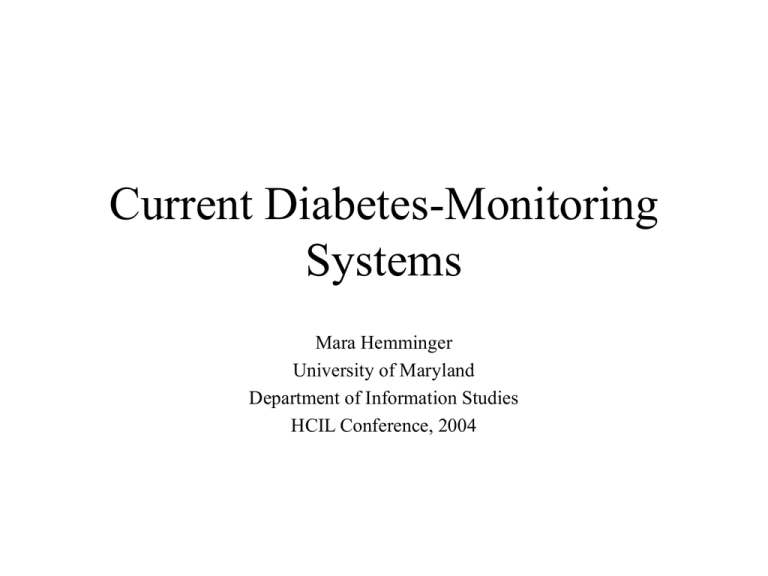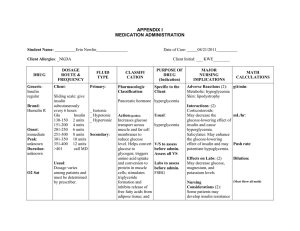Current Diabetes-Monitoring Systems Mara Hemminger University of Maryland
advertisement

Current Diabetes-Monitoring Systems Mara Hemminger University of Maryland Department of Information Studies HCIL Conference, 2004 Overview • What is diabetes? • What meters are currently available? • What record-keeping systems are currently available? • What research initiatives exist? • What are some user-interface issues? What Is Diabetes? • Body cannot process sugar properly. – Insulin controls the amount of sugar in blood. – Diabetics’ pancreas cannot produce / properly process insulin. • Types – Type 1 • Body produces little/no insulin (insulin injections needed) • Typically hits people under age of 30 – Type 2 • Body produces insufficient amounts of / improperly processes insulin (no insulin injections needed) • Typically hits adults over age of 40 – Gestational (during pregnancy) What Is Diabetes? • Can cause: – Blindness – Heart attack – Poor circulation – Gangrene – Kidney disfunction – Death. • No cure, but monitoring can prevent long-term problems What Meters Are Currently Available? • Types: – Blood glucose monitors * • Blood-pricking • Minimally-invasive • Non-invasive – Urine glucose monitors – A1c monitors • Features: – – – – – – – – Testing location Testing speed Blood amount required Storage of readings High/low values Size Cost of meter Cost of strips Blood-Prick Meters: Hand Logs (Accutech) • Drop blood onto meter • Wait 2 minutes • Read results on thermometer-like display • Compare reading with chart of average readings Blood-Prick Meters: PC-Based (LifeScan) • Meter • Arm or finger prick • Digital display of reading • Record-keeping system • Glucose • Measurements before and after meals • Colors indicate levels above/below target • Medications • Meals (carbohydrates) • Bar/pie charts, graphs • By date • By time-of-day • By target levels Blood-Prick Meters: PDA-Based (Therasense FreeStyle) • Meter – Multiple testing sites – Digital display of reading • Recording-keeping system – – – – Glucose levels Medications Meals Exercise Minimally Invasive Meters (MiniMed CGMS) • Insert sensor under abdominal skin for 72 hours • Sensor reads interstitial fluid glucose level • Patient can enter meals, exercise, meds in monitor • Physician reads sensor results • User must calibrate sensor via a finger prick 4x/day Non-Invasive Meters (Cygnus GlucoWatch) • Auto-Sensor fits on back of watch • Monitors glucose (u/i method); no blood-pricks • User can enter meals, exercise info • User can set high/low alert • Biographer stores 8,500 readings • Data can be downloaded to PC as graphs, charts, stats What Record-Keeping Systems Are Currently Available? • Types – – – – – Hand logs Spreadsheets Internet logs (hand) PC-based (here) * PDA-based • Here: (WinGlucoFacts) – Daily/weekly/mo stats – Bar chart, dot graphs What Research Initiatives Exist? (MIT/Frost & Smith) • Web-based tool • Patients photograph daily habits • Glucose readings stored and color-coded (red=high, blue=low) • Glucose readings mapped to photos • Goal: highlight bad habits What Research Initiatives Exist? (University of Pittsburgh/Schultz & Ballerstadt) • Sensor implanted below skin • Sensor fluorescence reflects blood sugar level • Photometer sits atop skin • Photometer measures intensity of fluorescence • Reminiscent of CGMS, but measurement method is known here What Are Some User-Interface Issues? • Meters – Eliminate blood-prick strips – Show test countdown – Show more than one reading at a time • Record-Keeping Systems – – – – Show personal high, low and average Track several factors (glucose, ketones, A1c, insulin) Provide analysis (only a few do) Multi-task: Measure, log, analyze, and inject insulin -all in one fell swoop!





